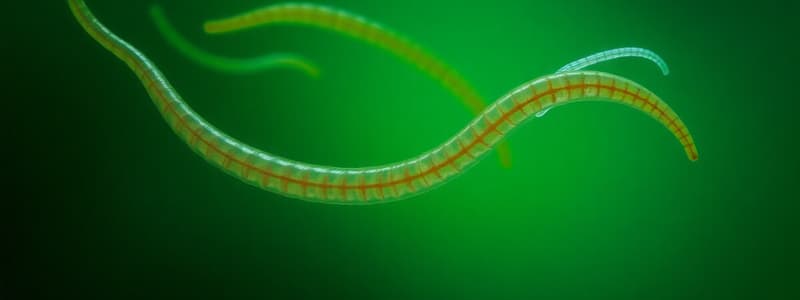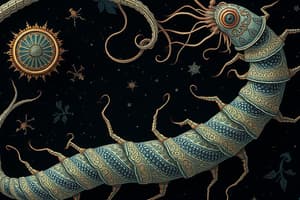Podcast
Questions and Answers
What type of symmetry do adult starfish exhibit?
What type of symmetry do adult starfish exhibit?
- Spherical symmetry
- Bilateral symmetry
- Radial symmetry (correct)
- Asymmetrical
What is the purpose of the tube feet in starfish?
What is the purpose of the tube feet in starfish?
- Respiration
- Locomotion (correct)
- Feeding
- Reproduction
Which class of echinoderms possesses a body with pentamerous discs and long arms?
Which class of echinoderms possesses a body with pentamerous discs and long arms?
- Echinoidea
- Holothuroidea
- Ophiuroidea (correct)
- Asteroidea
How do echinoids primarily respire?
How do echinoids primarily respire?
What distinguishes the body structure of Holothuroidea?
What distinguishes the body structure of Holothuroidea?
Which of the following correctly describes the sense organs of echinoderms?
Which of the following correctly describes the sense organs of echinoderms?
Which of the following animal examples belongs to the class Echinoidea?
Which of the following animal examples belongs to the class Echinoidea?
Which statement about echinoderm reproduction is true?
Which statement about echinoderm reproduction is true?
What type of digestive system do organisms in the phylum Annelida possess?
What type of digestive system do organisms in the phylum Annelida possess?
How is the circulatory system classified in Annelida?
How is the circulatory system classified in Annelida?
Which class of Annelida does not possess a clitellum?
Which class of Annelida does not possess a clitellum?
What is the main characteristic of the Polychaeta class regarding appendages?
What is the main characteristic of the Polychaeta class regarding appendages?
Which of the following is an example of a fireworm?
Which of the following is an example of a fireworm?
What distinguishes the blood flow in a closed circulatory system from an open circulatory system?
What distinguishes the blood flow in a closed circulatory system from an open circulatory system?
What reproductive characteristic is found in hermaphroditic species from Annelida?
What reproductive characteristic is found in hermaphroditic species from Annelida?
What notable feature do fireworms exhibit when releasing gametes?
What notable feature do fireworms exhibit when releasing gametes?
What unique feature distinguishes mammals from other classes?
What unique feature distinguishes mammals from other classes?
Which class includes bony fish that make up 98% of all fish?
Which class includes bony fish that make up 98% of all fish?
What is a defining characteristic of skates compared to rays?
What is a defining characteristic of skates compared to rays?
Which subclass of mammals is unique for laying eggs?
Which subclass of mammals is unique for laying eggs?
Which characteristic is true for reptiles?
Which characteristic is true for reptiles?
What adaptation do birds have that is not found in mammals?
What adaptation do birds have that is not found in mammals?
What is a common feature of amphibians, such as frogs and toads?
What is a common feature of amphibians, such as frogs and toads?
Which feature of osteichthyes aids in their buoyancy?
Which feature of osteichthyes aids in their buoyancy?
What primarily distinguishes vertebrates from other chordates?
What primarily distinguishes vertebrates from other chordates?
What type of fish is characterized as having a cartilaginous skeleton?
What type of fish is characterized as having a cartilaginous skeleton?
Which of the following features is NOT typical of Class Chondrichthyes?
Which of the following features is NOT typical of Class Chondrichthyes?
What is a common characteristic of vertebrate chordates during their early stages of development?
What is a common characteristic of vertebrate chordates during their early stages of development?
Which type of muscle is NOT present in vertebrates?
Which type of muscle is NOT present in vertebrates?
How do sharks and ratfish primarily differ from jawless fish?
How do sharks and ratfish primarily differ from jawless fish?
Which of the following statements about the heart structure of Chondrichthyes is true?
Which of the following statements about the heart structure of Chondrichthyes is true?
What characteristic is associated specifically with ratfish or chimeras?
What characteristic is associated specifically with ratfish or chimeras?
Which structure is responsible for respiration in Arthropods?
Which structure is responsible for respiration in Arthropods?
What is a characteristic feature of centipedes?
What is a characteristic feature of centipedes?
In which class of Arthropoda are most members aquatic?
In which class of Arthropoda are most members aquatic?
Which mode of fertilization is observed in Arthropods?
Which mode of fertilization is observed in Arthropods?
Which of the following is NOT a method of excretion for Arthropods?
Which of the following is NOT a method of excretion for Arthropods?
What distinguishes the body structure of insects from other arthropods?
What distinguishes the body structure of insects from other arthropods?
Which of the following represents a common group found within Myriapoda?
Which of the following represents a common group found within Myriapoda?
How does the head of most crustaceans differ from other arthropods?
How does the head of most crustaceans differ from other arthropods?
Which characteristic is NOT true about the body structure of mollusks?
Which characteristic is NOT true about the body structure of mollusks?
What is the primary function of the radula in mollusks?
What is the primary function of the radula in mollusks?
Which of the following habitats can mollusks be found in?
Which of the following habitats can mollusks be found in?
What type of symmetry do mollusks exhibit?
What type of symmetry do mollusks exhibit?
What role does the mantle play in mollusks?
What role does the mantle play in mollusks?
What is a unique respiratory feature of segmented worms?
What is a unique respiratory feature of segmented worms?
Which term best describes mollusks' reproductive method?
Which term best describes mollusks' reproductive method?
Which of the following is NOT a feature of phylum Annelida?
Which of the following is NOT a feature of phylum Annelida?
Flashcards
Asteroidea
Asteroidea
A group of marine invertebrates with a star-shaped body composed of five arms radiating from a central disc.
Regeneration
Regeneration
The ability of an organism to regrow lost or damaged body parts.
Water vascular system
Water vascular system
A system of fluid-filled canals and tube feet used for locomotion, feeding, and gas exchange in echinoderms.
Pedicellariae
Pedicellariae
Signup and view all the flashcards
Ophiuroidea
Ophiuroidea
Signup and view all the flashcards
Echinoidea
Echinoidea
Signup and view all the flashcards
Holothuroidea
Holothuroidea
Signup and view all the flashcards
Cloacal respiratory tree
Cloacal respiratory tree
Signup and view all the flashcards
Annelids
Annelids
Signup and view all the flashcards
Polychaeta
Polychaeta
Signup and view all the flashcards
Oligochaeta
Oligochaeta
Signup and view all the flashcards
Hirudinea
Hirudinea
Signup and view all the flashcards
Closed Circulatory System
Closed Circulatory System
Signup and view all the flashcards
Open Circulatory System
Open Circulatory System
Signup and view all the flashcards
Hermaphrodite
Hermaphrodite
Signup and view all the flashcards
Clitellum
Clitellum
Signup and view all the flashcards
What are the key features of Crinoids?
What are the key features of Crinoids?
Signup and view all the flashcards
Describe Annelids.
Describe Annelids.
Signup and view all the flashcards
What is the general body plan of Mollusks?
What is the general body plan of Mollusks?
Signup and view all the flashcards
What is the radula and its function?
What is the radula and its function?
Signup and view all the flashcards
What is the mantle and its purpose?
What is the mantle and its purpose?
Signup and view all the flashcards
What type of digestive system do Mollusks have?
What type of digestive system do Mollusks have?
Signup and view all the flashcards
How do Mollusks reproduce?
How do Mollusks reproduce?
Signup and view all the flashcards
Describe the symmetry of Annelids.
Describe the symmetry of Annelids.
Signup and view all the flashcards
Vertebrates
Vertebrates
Signup and view all the flashcards
Notochord
Notochord
Signup and view all the flashcards
Pharyngeal Gill Slits
Pharyngeal Gill Slits
Signup and view all the flashcards
Chondrichthyes (Cartilaginous Fish)
Chondrichthyes (Cartilaginous Fish)
Signup and view all the flashcards
Ratfish (Chimeras)
Ratfish (Chimeras)
Signup and view all the flashcards
Vertebrate Chordates
Vertebrate Chordates
Signup and view all the flashcards
Notochord Replacement
Notochord Replacement
Signup and view all the flashcards
Cephalization
Cephalization
Signup and view all the flashcards
Rays
Rays
Signup and view all the flashcards
Skates
Skates
Signup and view all the flashcards
Bony fish
Bony fish
Signup and view all the flashcards
Amphibians
Amphibians
Signup and view all the flashcards
Reptiles
Reptiles
Signup and view all the flashcards
Birds
Birds
Signup and view all the flashcards
Mammals
Mammals
Signup and view all the flashcards
Monotremata
Monotremata
Signup and view all the flashcards
What is the Phylum Arthropoda?
What is the Phylum Arthropoda?
Signup and view all the flashcards
What is Class Insecta?
What is Class Insecta?
Signup and view all the flashcards
What are Crustaceans?
What are Crustaceans?
Signup and view all the flashcards
What is molting?
What is molting?
Signup and view all the flashcards
What is a tracheal system?
What is a tracheal system?
Signup and view all the flashcards
What are Malpighian tubules?
What are Malpighian tubules?
Signup and view all the flashcards
What are wings?
What are wings?
Signup and view all the flashcards
What is metamorphosis?
What is metamorphosis?
Signup and view all the flashcards
Study Notes
NEMATODES
- These are commonly called thread or roundworms
- They are unsegmented, triploblastic, and pseudocoelomic
- Their bodies are cylindrical or thread-like, covered in a body wall with cuticle and epidermis
- Most are parasitic, but some are free-living
- They are elongated, slender worms, tapering at both ends
- Bilaterally symmetrical
- Organized at the organ system level
- Body cavity is filled with muscle tissue
- Body is unsegmented
- Body cavity (pseudocoelom) not lined by mesoderm
- Internal cephalization, little anterior-posterior differentiation
- Body is covered with tough and resistant cuticle
- Digestive system is complete and straight, with both mouth and anus
- Mouth is terminal, surrounded by lips with sense organs
- Respiratory and circulatory systems are absent
- Respiration occurs through the body surface (aerobic in free-living forms, anaerobic in parasitic forms)
- Excretory system is made up of intracellular canals or lateral excretory ducts
- Nervous system is rudimentary, with a circumpharyngeal nerve ring and longitudinal nerve cords
- Sense organs are poorly developed, like papillae, amphids (mouth), and phasmids (anus)
- Sexes are separate with sexual dimorphism
- Fertilization is internal, possibly cross or self
- Development may be direct or indirect
- Larval forms include rhabditiform, filariform, and microfilaria
ASCHELMINTHES
- Zoologists consider this a superphylum containing various groups
- This includes Rotifera, Gastrotricha, Kinorhyncha, Nematomorph, and Nematoda
- Phylum Nematoda is a significant group within it
GENERAL CHARACTERISTICS
- Mostly parasitic, though some are free-living
- Cylindrical, elongated
- Triploblastic
- Bilaterally symmetrical
- Organ system level of organization
- Body is unsegmented
- Body cavity is filled with muscle tissue
- Pseudocoelomate (body cavity not lined by mesoderm)
Studying That Suits You
Use AI to generate personalized quizzes and flashcards to suit your learning preferences.



